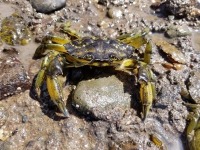
(Photo: Jaclyn Walker)
European Green Crab
Carcinus maenas
Green, brown, or greenish-yellow crab. Has a trapezoid-shaped carapace with serrated edges. It has three spines between its eyes and five on each side. Its carapace is up to nine centimetres in diameter.
Authority
Linnaeus, 1758
Classification Details
Phylum: Arthropoda (arthropods); Subphylum: Crustacea (crustaceans); Order: Decopoda (decapod crustaceans).
Habitat
Found on the shore and in shallow water, generally on muddy, sandy, or pebbly seabeds with seaweed. This species is native to Europe and northern Africa. It is an invasive species in Canadian waters and was first found here in 1951 in southwest New Brunswick. It is now present on the east coast of North America from Newfoundland to Virginia. It has also invaded other areas including western Canada, South Africa, South America, and Australia.
Diet
Green crabs aren’t fussy eaters. They eat a wide variety of food including seaweed, worms, and other crabs. But they seem to prefer molluscs such as mussels, clams, and scallops. They grab prey with their large front claws before chewing it up with their mouthparts.
Reproduction
Green crabs can be male or female. Males mate with females, transferring sperm using modified legs. The female usually lays her eggs several days after mating. She stores the eggs on her abdomen under her tail for several months. A female can release over 185 000 eggs. The eggs hatch into plankton-feeding larvae. The larval stage lasts up 80 days before the larvae change into small crabs. Green crabs live for four to seven years.
Fun Facts
The green crab can cause serious problems in the places it has invaded by impacting native species and ecosystems. It is such an efficient predator that it can out-compete native crab species for food. It disrupts eelgrass beds, which are an important habitat for juvenile fish and also destroys shellfish beds. They affect the fishing industry by reducing the amount of commercial species such as fish, molluscs, and crustaceans. Once green crabs have invaded, it is almost impossible to get rid of them. However, it may be possible to control population sizes by trapping and removing these crabs.
References
DFO (2011) Ecological Assessment of the Invasive European Green Crab (Carcinus maenas) in Newfoundland 2007–2009. DFO Canadian Science Advisory Secretariat Science Advisory Report 2010/033. Klassen G, Locke A (2007) A biological synopsis of the European green crab, Carcinus maenas. Canadian Manuscript Report Fisheries Aquatic Sciences 2818, 75pp.

